《林黛玉进贾府》教学设计 教案教学设计共3篇
林黛玉进贾府教学设计(优秀4篇)

A、拜见众人时。“忙起身…”
B、在刑夫人处。婉谢留饭,既表明了对邢夫人的尊敬和感激,又表明了自己顾全大局礼节,说明她待人接物处处留心。
C、在王夫人房中。她不接受王夫人让她东坐,因料定那是贾政之位,是绝不应坐的,便向挨炕的椅上坐了。这看来事小,但她绝不轻易从事。
D、在贾母房中吃饭时。为座位事黛玉更是推让了一番,直到贾母做了解释,她才肯入座。
⑵初见凤姐(重点)→高潮。
⑶拜见两位舅父(未见)。
⑷陪贾母晚餐。
⑸宝黛会面(重点)→最高潮。
结尾:安排起居。
四、小结
本文第一次向读者展现小说中众多人物活动的典型环境──贾府;第一次描写小说中的一批主要人物;第一次描写小说主人公宝黛初次相见时的似曾相识、心心相通的微妙关系。
第二教时
〖明确目标〗
贾府典型环境分析。
⑶小结:
宝玉生活在封建贵族家庭,处在封建正统势力的重重包围中,他是中国封建社会末期的母腹中开始孕育的“新人”的胚胎。
4、析“宝黛相会”──“心有灵犀一点通”:
⑴宝黛初会时两人分别什么感觉?为什么会有这种不同的感觉?
明确:
⑶小结:
王熙凤是贾府之中杀伐决断,威重令行的铁腕人物。曹雪芹在王熙凤的塑造上,是不遗余力的,仅在这第一次的出场中,王熙凤就给读者留下了深刻的印象。无怪乎脂砚斋慨叹道:“试问诸公,从来小说中可有写形追象至此者?”
曹雪芹评:[聪明泪]机关算尽太聪明,反算了卿卿性命!生前心已碎,死后性空灵。家富人宁,终有个家亡人散各奔腾。枉费了,意悬悬半世心,好一似,荡悠悠三更梦。忽喇喇似大厦倾,昏惨惨似灯将尽。呀!一场欢喜忽悲辛。叹人世,终难定!
第三教时
〖教学目标〗
人物形象分析。
〖教学过程〗
《林黛玉进贾府》教案(苏教版高一必修教案设计)共3篇

《林黛玉进贾府》教案(苏教版高一必修教案设计)共3篇《林黛玉进贾府》教案(苏教版高一必修教案设计)1《林黛玉进贾府》教案(苏教版高一必修教案设计)一、教材分析本教案所讲授的教材为苏教版高一必修的《红楼梦》。
这本著名的古典小说分为一百二十回,描写了大观园内的多种人物形象以及他们之间的许多复杂的关系,以展现出清朝封建社会的种种弊端和社会问题。
而作为小说的代表人物之一,林黛玉是一个极具代表性的女性角色,她的思想和情感的变化,以及与其他人物之间的关系,都表现了作家曹雪芹深刻的洞察力和深情笔力。
本教案将以《程诚与黛玉谈心》和《宝钗、黛玉论诗》两个篇章为主,分别分析林黛玉这个角色的性格、情感和思想,并通过分析同其他人物的关系,切实掌握故事情节和主题。
二、教学目标1. 学生掌握林黛玉这个角色的性格、情感和思想,并了解她在小说中的作用。
2. 学生能够分析林黛玉与其他人物之间的关系,理解故事情节和主题。
3. 学生能够准确地理解和阅读小说中涉及的难词和古文。
4. 学生能够通过小组合作和讨论,有效地分享学习成果和感受。
三、教学重点和难点1. 教学重点:了解林黛玉这个角色的性格、情感和思想,掌握与其他人物之间的关系,理解故事情节和主题。
2. 教学难点:阅读小说中涉及的难词和古文,准确理解和把握小说的情节和主题。
四、教学方法1. 教师讲解配合学生阅读,逐步深入地了解林黛玉这个角色的性格、情感和思想。
2. 分组合作,让学生彼此分享自己对于林黛玉的理解和体验。
3. 进行多层次的词语、成语和句子分析,帮助学生理解小说。
四、教学过程第一节:程诚与黛玉谈心1. 分组讨论:小组讨论描述黛玉的性格特点。
每组讨论结果汇总,并形成总的性格特征表。
2. 教师引导学生,让学生根据林黛玉的性格特点和行为来解读她和程诚之间的谈心。
请学生阅读相关的段落,整理出来关键词汇。
3. 教师让学生运用“四步阅读法”来分析这段话。
帮助学生加深对林黛玉思想和情感的理解。
《林黛玉进贾府》优秀教学设计优秀3篇

《林黛玉进贾府》优秀教学设计优秀3篇《林黛玉进贾府》教案篇一教学目的:初步了解曹雪芹和他的《红楼梦》及其思想和艺术成就通过多本文的学习,把握主要人物的性格特征及表现人物的手法。
教学重点:典型环境和主要人物王熙凤、贾宝玉、林黛玉的性格特征。
教学时数:两课时教学方法:以点拨为主,引导学生逐步领会第一课时教学目的:初步了解曹雪芹和他的《红楼梦》及其思想和艺术成就;整体把握课文内容。
教学内容和步骤:导入:如果从中国古典小说中找出一部能像“百科全书”一样充分表现封建社会历史、能被誉为“金字塔”式的作品,你会首选什么?——《红楼梦》。
它的作者是谁?——曹雪芹。
你了解曹雪芹吗?你看过《红楼梦》吗?一。
曹雪芹与《红楼梦》简介曹雪芹:出身于一个有百年历史的贵族世家:曾祖母是康熙皇帝的奶妈;曾祖父、祖父、父亲和叔父三代世袭江宁织造(皇家的供货商);两个姑姑都被选为王妃;康熙皇帝六次南巡,其中有四次住在他的家里。
成长于一个藏书丰富的书香门第:祖父曾是当地名士,能写诗、填词、编戏;还是有名的藏书家;主持刻印了《全唐诗》;曹雪芹深受祖父和家庭的影响,从小博览群书,有丰厚的文学文化底蕴,琴棋书画无所不能,诗词曲赋无所不精,不但是杰出的小说家,还是有名的诗人和画家。
生活于所谓的“康乾盛世”,但经历了大家族由盛而衰的巨大变故。
人生经历:十三岁前:正当曹家极盛时期,在南京过着“锦衣纨裤”“饫甘餍肥”的豪华生活。
其后:父亲获罪革职,家产被查抄,全家由南京迁到北京,青壮年是在家境由盛而衰的过程中度过的。
晚年:在北京西郊,生活日渐贫困,竟然到了食粥赊酒、围毡御寒、卖画谋生的境地。
死亡:四十多岁,约在一七六四年除夕,因贫病无医,加上爱子夭折,过度伤痛,而痛苦地离开了人间。
身后留下凄苦的妻子和几束残稿,连埋葬的费用都是他几个好友资助的。
写作经历:写于凄凉困苦的晚年。
在“曹雪芹印”中有这样一首诗:“我也曾金马玉堂,我也曾瓦灶绳床。
你笑我名门落拓,一腔惆怅,怎知我看透了天上人间、世态炎凉!褴裳藏傲骨,愤世写群芳。
《林黛玉进贾府》教案(优秀7篇)
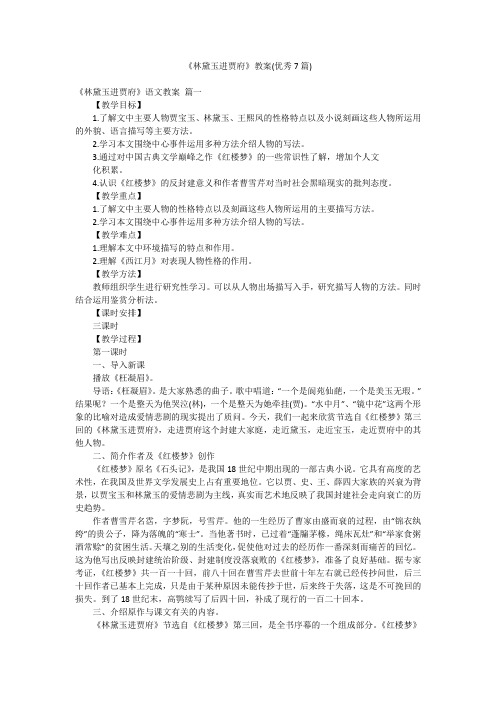
《林黛玉进贾府》教案(优秀7篇)《林黛玉进贾府》语文教案篇一【教学目标】1.了解文中主要人物贾宝玉、林黛玉、王熙凤的性格特点以及小说刻画这些人物所运用的外貌、语言描写等主要方法。
2.学习本文围绕中心事件运用多种方法介绍人物的写法。
3.通过对中国古典文学巅峰之作《红楼梦》的一些常识性了解,增加个人文化积累。
4.认识《红楼梦》的反封建意义和作者曹雪芹对当时社会黑暗现实的批判态度。
【教学重点】1.了解文中主要人物的性格特点以及刻画这些人物所运用的主要描写方法。
2.学习本文围绕中心事件运用多种方法介绍人物的写法。
【教学难点】1.理解本文中环境描写的特点和作用。
2.理解《西江月》对表现人物性格的作用。
【教学方法】教师组织学生进行研究性学习。
可以从人物出场描写入手,研究描写人物的方法。
同时结合运用鉴赏分析法。
【课时安排】三课时【教学过程】第一课时一、导入新课播放《枉凝眉》。
导语:《枉凝眉》。
是大家熟悉的曲子。
歌中唱道:“一个是阆苑仙葩,一个是美玉无瑕。
”结果呢?一个是整天为他哭泣(林),一个是整天为她牵挂(贾)。
“水中月”、“镜中花”这两个形象的比喻对造成爱情悲剧的现实提出了质问。
今天,我们一起来欣赏节选自《红楼梦》第三回的《林黛玉进贾府》,走进贾府这个封建大家庭,走近黛玉,走近宝玉,走近贾府中的其他人物。
二、简介作者及《红楼梦》创作《红楼梦》原名《石头记》,是我国18世纪中期出现的一部古典小说。
它具有高度的艺术性,在我国及世界文学发展史上占有重要地位。
它以贾、史、王、薛四大家族的兴衰为背景,以贾宝玉和林黛玉的爱情悲剧为主线,真实而艺术地反映了我国封建社会走向衰亡的历史趋势。
作者曹雪芹名霑,字梦阮,号雪芹。
他的一生经历了曹家由盛而衰的过程,由“锦衣纨绔”的贵公子,降为落魄的“寒士”。
当他著书时,已过着“蓬牖茅椽,绳床瓦灶”和“举家食粥酒常赊”的贫困生活。
天壤之别的生活变化,促使他对过去的经历作一番深刻而痛苦的回忆。
林黛玉进贾府优秀教案(精选5篇)

林黛玉进贾府优秀教案(精选5篇)林黛玉进贾府优秀教案(1)一、设疑课文预习提示对《红楼梦》的基本内容作过交待。
假如我们从林黛玉进贾府的过程一路学将下来,似乎也没有什么不可,但是这样一来,学生只是被动地接受教师的教习,并没有摆脱满堂灌的嫌疑,也不能发挥出学生自主学习的积极性。
进一步说,不利于发展学生发现问题,分析问题和解决问题的能力,而学生的创新能力也在无形中被常规教学所忽视了。
于是我想何不就以林黛玉和贾宝玉的爱情发展作为讲课的一个切入点进行带点创新意识的教学呢?打定主意,便着手进行。
先设定本课的讲习目的:“通过对课文人物描写的理解分析,提高学生获取,提高学生获取、感受、品味语言的信息的能力,培养学生的文学鉴赏能力和综合语言能力,增强学生对《红楼梦》的构思艺术的理解。
”教学方法:“启发、讨论式教学。
”然后设定教学的过程,在预读《红楼梦》的情况下,请同学谈他对《红楼梦》的初步认识。
如全书的内容,艺术价值等,都要求用简练的语言加以概话。
其目的是,通过一切可能的途径培养学生的语言表达能力。
待学生完成后,教师提示并肯定:鲁迅先生说:“自从《红楼梦》出来以后,传统的思想和写法都打破了。
”《红楼梦》确实是一部了不起的文学品。
自从它行世以来,就不知迷恋了多少读者。
课文所选的第三回就初步展示了《红楼梦》高超的艺术技巧,从而把学生的学习方位加以确认。
二、激疑在设疑的基础上,请同学读课文的预习提示。
读完后,引导学生注意本段的叙述顺序,发现问题:原来,《红楼梦》以贾宝玉和林黛玉的爱情悲剧为主线,真实而艺术地反映了我中封建社会走向衰亡的历史趋势。
林黛玉与贾宝玉之间的爱情故事原来是小说的主要描写对象。
本篇课文虽然写林黛玉初进贾府的所见所闻,但也重点交待了林黛玉和贾宝玉初次相会二人细腻而微妙的感情关系。
可以说,整个《红梦楼》中林黛玉、贾宝玉的爱情发展能否一帆风顺,从这一回里就看出来了。
如果教师能引导学生感受到这一点,那么以林黛玉和贾宝玉的情感描写来感受《红楼梦》高超的艺术这一教学任务就完成了。
高一语文林黛玉进贾府教案【三篇】
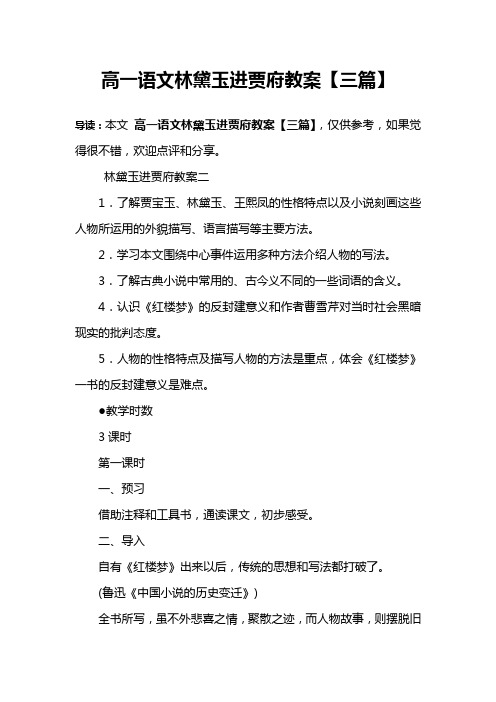
高一语文林黛玉进贾府教案【三篇】导读:本文高一语文林黛玉进贾府教案【三篇】,仅供参考,如果觉得很不错,欢迎点评和分享。
林黛玉进贾府教案二1.了解贾宝玉、林黛玉、王熙凤的性格特点以及小说刻画这些人物所运用的外貌描写、语言描写等主要方法。
2.学习本文围绕中心事件运用多种方法介绍人物的写法。
3.了解古典小说中常用的、古今义不同的一些词语的含义。
4.认识《红楼梦》的反封建意义和作者曹雪芹对当时社会黑暗现实的批判态度。
5.人物的性格特点及描写人物的方法是重点,体会《红楼梦》一书的反封建意义是难点。
●教学时数3课时第一课时一、预习借助注释和工具书,通读课文,初步感受。
二、导入自有《红楼梦》出来以后,传统的思想和写法都打破了。
(鲁迅《中国小说的历史变迁》)全书所写,虽不外悲喜之情,聚散之迹,而人物故事,则摆脱旧套,与在先之人情小说甚不同。
要点在敢于如实描写,并无讳饰。
(鲁迅《中国小说史略》)三、作者简介及《红楼梦》创作:《红楼梦》是我国18世纪中期出现的一部古典小说。
它高度的艺术性,在我国及世界文学发展占有重要地位。
作者曹雪芹,名,字梦阮,号雪芹。
大约生于1715年,卒于1763年。
他祖先原是汉人,但很早成了正白旗内务府的“包衣”(满语奴隶之意),入了满籍。
从他曾祖曹玺开始,三代世龚江宁织造的官职。
祖父曹寅做过康熙的“侍读”,两个女儿都被入选为王妃。
在康熙时,曹家是非常显赫的贵族世家。
雍王即位后,曹雪芹的父亲曹因与皇家派别斗争有牵连,以及在江宁织造任期内财款亏空等原因,被罢官,抄家,家道从此衰落。
作者的一生恰好经历了曹家由盛而衰的过程,由“锦衣纨裤”的贵公子,降为落魄的“寒士”。
当他著书时,已过着“蓬牖茅椽,绳床瓦灶”和“举家食粥酒常赊”的贫困生活。
这种天壤之别的生活变化,促使他对过去的经历作一番深刻而痛苦的回忆。
这就为他能对社会上种种黑暗抱有不满和批判的态度,写出反映封建统治阶级、封建制度没落衰败的《红楼梦》,准备了良好基础。
林黛玉进贾府教案范文(精选5篇)

林黛玉进贾府教案范文(精选5篇)林黛玉进贾府教案范文(精选5篇)作为一名教师,通常会被要求编写教案,通过教案准备可以更好地根据具体情况对教学进程做适当的必要的调整。
教案要怎么写呢?下面是小编精心整理的林黛玉进贾府教案范文(精选5篇),欢迎阅读与收藏。
林黛玉进贾府教案1【教学目标】1、知识目标(1)了解《红楼梦》的主要内容和它的思想性、艺术性及其在文学史上的地位,激发学生的阅读兴趣。
(2)学生分析通过人物的外表、语言、行动和心态表现人物性格的写法,学习课文用肖像描写反映人物特征的写作技巧。
(3)区分、了解、并应用小说的相关写作手法。
2、能力目标(1)分析形象,培养学生良好的分析习惯和知识迁移地能力。
(2)通过学习使学生提高分析、归纳、评价、写作等综合能力。
3、情感态度与价值观目标(1)在研读小说过程中,培养审美眼光,领会人物的美感。
(2)正确理解《红楼梦》的思想内涵,培养学生热爱祖国传统文化的思想感情;认识封建大家族的腐朽没落,理解贾宝玉追求个性自由反封建的精神。
【教学重点、难点】1.重点:典型的环境描写,个性化的语言,分析人物的性格特点及刻画人物的写作手法,体会作品如何根据人物外貌描写来体现性格特点。
2.难点:提高学生阅读小说的能力以及写作能力。
【教学策略】1、教法:讨论法、提问法、多媒体辅助教学、欣赏教学法、情境教学法、还原法等综合运用2、教学对象分析及策略:现在高一文科班学生课外阅读量小面窄,本着巩固基础、迁移知识、加强能力的原则,强调突出重点、分散突破难点,补充延伸教材内容,采用设疑激趣、启发调动的方式,拓展学生的知识面,调动学生的主观能动性,开发学生的潜能,从而顺利完成教学任务。
3、用具媒体组合运用:多媒体平台、学生搜集的资料等。
4、资源开发利用:语文教材、《红楼梦》以及学生搜集、整理的各种资料等。
【课时安排】:三课时课前预习【预习提示】现存的《红楼梦》有甲戌本、乙卯本、庚辰本、舒序本,这四个版本。
【高一语文林黛玉进贾府教案【三篇】】 林黛玉进贾府教案
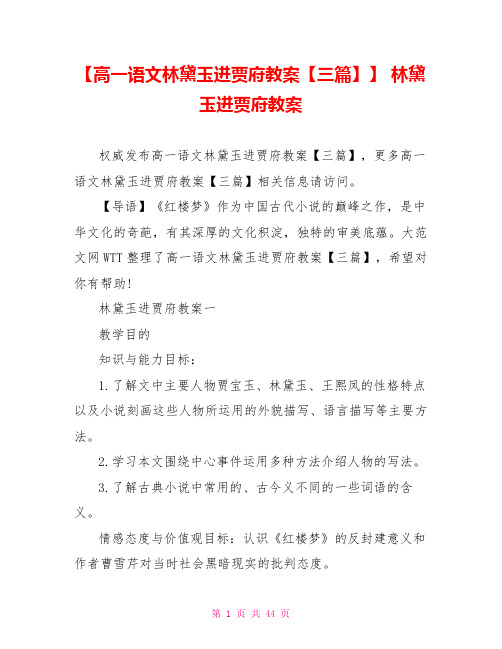
【高一语文林黛玉进贾府教案【三篇】】林黛玉进贾府教案权威发布高一语文林黛玉进贾府教案【三篇】,更多高一语文林黛玉进贾府教案【三篇】相关信息请访问。
【导语】《红楼梦》作为中国古代小说的巅峰之作,是中华文化的奇葩,有其深厚的文化积淀,独特的审美底蕴。
大范文网WTT整理了高一语文林黛玉进贾府教案【三篇】,希望对你有帮助!林黛玉进贾府教案一教学目的知识与能力目标:1.了解文中主要人物贾宝玉、林黛玉、王熙凤的性格特点以及小说刻画这些人物所运用的外貌描写、语言描写等主要方法。
2.学习本文围绕中心事件运用多种方法介绍人物的写法。
3.了解古典小说中常用的、古今义不同的一些词语的含义。
情感态度与价值观目标:认识《红楼梦》的反封建意义和作者曹雪芹对当时社会黑暗现实的批判态度。
教学过程与方法:教学设想1.教学重点是分析主要人物的性格特点,并指导学生学习小说所运用的刻画人物的主要方法。
2.思想教育的重点是让学生正确认识《红楼梦》这部古典名著的反封建的重要意义。
这种思想教育渗透在教学过程中,则主要是通过对人物形象,特别是对贾宝玉的分析完成的。
3.《红楼梦》的开头四回是全书的序幕,为后面展开情节、刻画人物作了铺垫。
教师简要介绍开头四回的主要内容,以使学生能更好地理解本文的内容。
4.以教师分析讲解为主。
教学时数:3教时。
第一教时教学要点教师简要介绍作者、作品、《红楼梦》开头四回的主要内容;认字解词;分析课文的情节结构。
教学内容与步骤1.教师介绍曹雪芹和《红楼梦》曹雪芹,名霑,字梦阮,号雪芹。
生于1715年,卒于1763年。
康熙皇帝时,曹雪芹家是非常显赫的贵族世家。
雍正皇帝即位之后,曹雪芹的父亲因与皇家派别斗争有牵连,被罢官抄家,曹家从此败落了。
曹雪芹的一生经历了曹家由兴盛到衰败的过程,早年过着豪华的公子生活,晚年却穷愁潦倒,卖画度日,生活于贫困之中。
这种天壤之别的生活变化,促使曹雪芹深刻地思考自己的经历,对社会上种种黑暗产生了不满,这就为创作《红楼梦》打下了良好的基础。
林黛玉进贾府(苏教版高一必修) 教案教学设计共3篇

林黛玉进贾府(苏教版高一必修) 教案教学设计共3篇林黛玉进贾府(苏教版高一必修) 教案教学设计1林黛玉进贾府教案教学设计一、教学目标1. 知识目标:学生能够理解《红楼梦》中林黛玉进入贾府的情节,理解文学作品中的情感描绘和人物性格描写。
2. 能力目标:学生能够分析文学作品中的情节和人物性格,感受文学作品中的情感渲染。
3. 情感目标:通过学习《红楼梦》中的情节和人物,使学生更加深入地理解人性、人情与社会关系,从而增强其人文素养。
二、教学重点1. 《红楼梦》情节分析2. 《红楼梦》人物性格描写3. 《红楼梦》情感渲染三、教学难点1. 引导学生理解小说中复杂的人际关系2. 帮助学生理解人物的性格特点3. 帮助学生感受文学作品中深刻的情感渲染四、教学方法1. 典型案例法:通过呈现林黛玉进入贾府的情节,帮助学生理解小说中的复杂人际关系。
2. 对比分析法:通过比较林黛玉与其他人物的性格特点,帮助学生理解人物的性格特点。
3. 体验式教学法:通过让学生身临其境,模拟小说中的情节,帮助学生感受文学作品中的情感渲染。
五、教学流程1. 授课前的准备工作教师提前准备好了《红楼梦》第三十一回的文本,准备好了多媒体设备和教具。
2. 导入教师引导学生回顾之前的课程,回顾林黛玉的人物形象。
通过提问,激发学生的学习兴趣和表达热情。
3. 学习过程(1) 第一步,帮助学生理解林黛玉进入贾府的情节师生一起阅读《红楼梦》第三十一回的文本,呈现林黛玉进入贾府的情节。
通过典型案例法,引导学生分析小说中复杂的人际关系。
(2) 第二步,分析人物性格特点通过对比分析法,让学生分析林黛玉与其他人物的性格特点。
引导学生分析人物行为的根源和内在动机。
(3) 第三步,感受情感渲染通过模拟小说中的情节,在课堂上体验鲜明的情感渲染。
通过体验式教学法,帮助学生感受小说中深刻的情感渲染。
4. 升华通过课堂上的互动学习,让学生在分析与体验中更深刻地感受到文学作品的魅力。
林黛玉进贾府教案(3篇)

林黛玉进贾府教案(3篇)《林黛玉进贾府》教案篇一《林黛玉进贾府》节选自《红楼梦》第三回,是全书序幕的一个组成部分。
林黛玉进贾府的行踪是这一回中介绍贾府人物、描写贾府环境的线索。
这节课我设置的学习重点是林黛玉人物形象的分析,欣赏精彩的人物语言。
学习的难点是如何体会作品如何根据人物外貌描写来概括性格特点,同时要注意一些古今词义的变化。
在上这节课之前,我引导学生:《红楼梦》写人物已经改变了以往古代小说人物类型化单一化的写法,塑造出成群性格鲜明的人物,其中林黛玉就是一个典型。
这样的引导不仅能使学生明白《红楼梦》在人物描写上的成就,还能让学生更易理解林黛玉的性格不是单一的,而是丰富和深刻的。
很多教师喜欢用电视剧《红楼梦》中的人物剧照或电视剧片段来活跃调节课堂气氛。
但这样做容易让学生的注意力集中在片中人物的外在形象上,而忽略了对名著语言的品味鉴赏,这与语文教学的宗旨是相悖的。
语文课就是要培养学生对语言文字的感觉,提高学生的语文素养。
我充分利用语言文字的间接性,通过“点评式读书法”的介绍和运用,再加上对欣赏方法的适当点拨,引导学生尽可能地贴近文字,走进文字,与语言文字亲密接触,从而领略文字所蕴涵的丰富内容,从文字中感受形象,感受文学大师运用文字的高超技艺,提高学生的欣赏水平。
在教学环节的设置上,我让学生充分发挥主体作用,说出自己对文中林黛玉的理解。
在指导理解的过程中,我让学生把众人眼里的黛玉、王熙凤眼里的黛玉、宝玉眼里的黛玉,三处描写放在一起,加以比较。
让学生在比较中体会不同人物眼中不同的林黛玉,不同的描写多角度、有层次地层现林黛玉的音容笑貌、神态风度,写意和工笔两种手法交替使用,既有朦胧的美感,又有清晰的美感。
对《林黛玉进贾府》这篇文章我具体的抓住了以下几个重点:1、关于王熙凤这个人物的分析,可从语言、容貌入手,学生一般也能理解这个人的性格特征,“未见其人,先闻其声,明是一把火,暗是一把刀”。
2、优美的语言可以给人无限想象的空间。
林黛玉进贾府教学设计(精选3篇)

林黛玉进贾府教学设计(精选3篇)林黛玉进贾府教学设计1教学目标:1、初步了解《红楼梦》和曹雪芹2、鉴赏主要人物林黛玉的形象美3、学习文中描写人物的手法学习重、难点:鉴赏主要人物的形象美及学习描写人物的手法课前预习一、作者及作品:曹雪芹(1715-1763?)名霑,字梦阮,号雪芹。
曹雪芹的一生经历了曹家由兴盛到衰败的过程,早年过着豪华的公子生活,晚年却穷愁潦倒,卖画度日,生活于贫困之中。
这种天壤之别的生活变化,促使曹雪芹深刻地思考自己的经历,对社会上种种黑暗产生了不满,这就为创作《红楼梦》打下了良好的基础。
《红楼梦》是他一生“披阅十载,增删五次”“字字看来皆是血,十年辛苦不寻常”的产物。
《红楼梦》,又名《石头记》,是一部具有高度思想性和高度艺术性的伟大作品,在我国文学史和世界文学史上都占有重要的地位。
全书以贾宝玉和林黛玉的爱情故事为中心,揭露了封建统治阶级的罪恶和腐朽本质,揭示了封建社会必然崩溃的历史发展趋势。
二、补充《红楼梦》内容:第一回是开篇。
先用“女娲补天”、“木石前盟”两个神话故事作楔子,为塑造贾宝玉的性格和描写贾宝玉和林黛玉的爱情故事,染上一层浪漫主义色彩。
第二回是交代贾府人物。
通过“冷子兴演说荣国府”,简要地介绍了贾府中的人物关系,为读者阅读全书开列了一个简明“人物表”。
第三回是介绍小说的典型环境,通过林黛玉的耳闻目睹对贾府做了第一次直接描写。
林黛玉进府的行踪是这一回中介绍贾府人物,描写贾府环境的线索。
第四回是展现小说更广阔的社会背景。
通过“葫芦僧判断葫芦案”介绍了贾、史、王、薛四大家族的关系,把贾府置于一个更广阔的社会背景之中来描写,使之更具有典型意义。
同时由于薛蟠的案件自然带出薛宝钗进贾府的情节。
第五回是全书的总钢。
通过贾宝玉梦游太虚幻境,利用画册、判词及歌曲的形式,隐喻含蓄地将《红楼梦》众多主要人物和次要人物的发展和结局交代出来。
《红楼梦》只流传下八十回,续写部分对于《红楼梦》中人物的命运,基本上是依据这些隐喻揣摩出来的。
《林黛玉进贾府》教学设计(精选3篇)

《林黛玉进贾府》教学设计(精选3篇)林黛玉进贾府教学设计篇一教学目标:知识技能掌握:阅读古代小说的方法,初步了解《红楼梦》和曹雪芹过程方法:1、了解课文中怎样描写贾府这一典型环境,环境描写的作用及特点。
2、从分析宝黛及王熙凤的不同性格入手,学习刻画人物的方法。
情感态度、价值观认识《红楼梦》这部古典名著的反封建意义。
教学重点分析主要人物的形象教学难点学习通过多种手法刻画人物的方法知识结构与教学设计王熙凤精明能干、惯于玩弄权术肖像、语言、动作为人刁钻狡黠、善于阿谀奉承见风使舵、笑里藏刀黛玉有极强的自尊心、美貌多情肖像、言行谨小慎微、体弱多病、多愁善感眉清目秀英俊多情肖像、言行似傻如痴离经叛道正面描写和侧面宝玉封建贵族的叛逆者描写相结合具有反抗封建束缚要求自由平等的思想教学过程一、导语设计《林黛玉进贾府》通过林黛玉的眼睛对贾府的布局装饰等有了初步的了解,那么在贾府这样奢华的环境中,生活着一些什么样的任务呢?这节课我们共同来探讨。
二、细读课文,分析人物形象1、王熙凤是一个怎样的人?节选部分是从哪几个方面展示王熙凤的性格特征的?(1)对肖像的描绘特别的服饰:珠光宝气——暗示她的贪婪与俗气,从侧面反映了她内心世界的空虚。
特别的容貌:“三角眼”“吊梢眉”“粉面”“丹唇”——表现她美丽的外表下隐藏着刁钻与狡黠的本性。
(2)见黛玉时的言行“天下真有这样标致的人物”“嫡亲的孙女”“可怜我这妹妹这样命苦”“该打该打”——善于奉承随机应变(3)回王夫人话充分表现了她果断能干的才能与善于机变逢迎的本事。
(这正是她赢得欢心,成为掌权人的原因)小结:精明能干、惯于权术、为人刁钻狡黠、善于阿谀奉承、见风使舵、笑里藏刀关于林黛玉(1)、原文中哪一句话能说明林黛玉的性格特征?————因此步步留心,时时在意,不肯多说一句话,多行一步路。
(2)、黛玉进贾府,为什么要“步步留心,时时在意,不肯多说一句话,多行一步路?————林黛玉在母亲去世后“上无亲母教养,下无妹妹兄弟扶持,在外祖母一再执意下,才去投奔外祖母家,依傍外祖母及舅氏姐妹。
2023年《林黛玉进贾府》教案三篇【新版】

2023年《林黛玉进贾府》教案三篇《林黛玉进贾府》教案篇1《红楼梦》中《林黛玉进贾府》一节描写了林黛玉初进贾府时的情景。
作者通过不同人物的语言展现了贾府众人的不同态度,寥寥数语就刻画出了不同人物的性格特点,极为生动传神。
一问一答之间,各人性情跃然纸上,对比读来,鲜明有趣。
笔者试以王熙凤见黛玉和贾宝玉见黛玉时的语言为例,说说各人不同心理、性格与感情。
一、王熙凤见黛玉──表演见黛玉前,王熙凤刻意来晚,高声笑语表现了她在贾府中的特殊身份和地位;精心装扮,簇拥而入,显示了自己的富贵豪华。
见黛玉时的“携手”、“细细打谅”后“仍送至贾母身边坐下”的动作,和忽喜忽悲、处处围绕老祖宗的一番言语,无不显示她的机变逢迎,世故圆滑。
这些内容,前人已有了细致的分析,__不再赘述。
而接下来的几句问话,却颇令人玩味:王熙凤又忙携黛玉之手,问:“妹妹几岁了?可也上过学?现吃什么药?在这里不要想家,想要什么吃的,什么玩的,只管告诉我;丫头老婆不好了,也只管告诉我。
”一面又问婆子们:“林姑娘的行李东西可搬进来了?带了几个人来?你们赶早打扫两间下房,让他们去歇歇。
”这王熙凤一连问了黛玉三个问题:年龄、读书、身体,表面一看,快人快语,待人爽朗而热情,对黛玉各方面的情况都十分关心。
但实际上,她真是在关心黛玉吗?细细读来,不是。
三个问题连贯问下,黛玉来得及回答吗?王熙凤想要黛玉回答吗?没有。
她没有工夫听,也不想听,这不是她的目的所在。
她的目的是什么呢?接下来的两个“只管告诉我”,以及询问婆子们的两句话和接着下的一道命令,令我们有些感觉了:贾府中谁说了算?我便是贾府中说话算数的主!可见,她的“热情”的话语只能有一个目的,就是要把她在贾府中的特殊身份和地位明白地告诉黛玉:听我的,没错。
这就和她的出场一样,一言一行都是表演,这表演极富心机,刻意求工,可谓“机关算尽”,世故圆滑之外又锋芒暗蕴,令人感喟不已。
二、贾宝玉见黛玉──真纯宝玉换了衣出来拜见贾母,“看见多了一个姊妹,忙来作揖。
《林黛玉进贾府》教案范文(通用3篇)
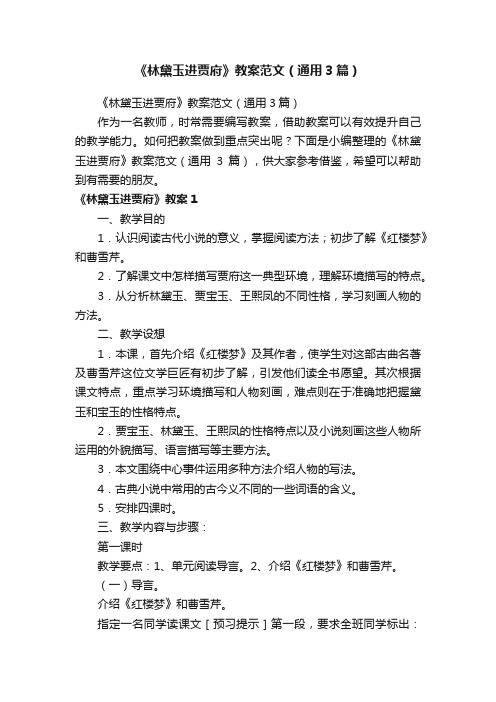
《林黛玉进贾府》教案范文(通用3篇)《林黛玉进贾府》教案范文(通用3篇)作为一名教师,时常需要编写教案,借助教案可以有效提升自己的教学能力。
如何把教案做到重点突出呢?下面是小编整理的《林黛玉进贾府》教案范文(通用3篇),供大家参考借鉴,希望可以帮助到有需要的朋友。
《林黛玉进贾府》教案1一、教学目的1.认识阅读古代小说的意义,掌握阅读方法;初步了解《红楼梦》和曹雪芹。
2.了解课文中怎样描写贾府这一典型环境,理解环境描写的特点。
3.从分析林黛玉、贾宝玉、王熙凤的不同性格,学习刻画人物的方法。
二、教学设想1.本课,首先介绍《红楼梦》及其作者,使学生对这部古曲名著及曹雪芹这位文学巨匠有初步了解,引发他们读全书愿望。
其次根据课文特点,重点学习环境描写和人物刻画,难点则在于准确地把握黛玉和宝玉的性格特点。
2.贾宝玉、林黛玉、王熙凤的性格特点以及小说刻画这些人物所运用的外貌描写、语言描写等主要方法。
3.本文围绕中心事件运用多种方法介绍人物的写法。
4.古典小说中常用的古今义不同的一些词语的含义。
5.安排四课时。
三、教学内容与步骤:第一课时教学要点:1、单元阅读导言。
2、介绍《红楼梦》和曹雪芹。
(一)导言。
介绍《红楼梦》和曹雪芹。
指定一名同学读课文[预习提示]第一段,要求全班同学标出:《红楼梦》“以贾、史、王、薛四大家族的兴衰为背景,以贾宝玉和林黛玉的爱情悲剧为主线,真实而艺术地反映了我国封建社会走向衰亡的历史趋势。
”然后补充介绍如下:《红楼梦》原名《石头记》,是我国古代小说中最杰出的现实主义作品。
它产生于清代所谓:“河清海晏”的“乾隆盛世”。
当时随着经济的恢复和发展,资本主义的因素也有了增长。
这股新的力量与严重束缚它的封建主义体系不可避免地产生冲突。
这种冲突反映在上层建筑领域便是处于萌芽状态却蓬勃而有朝气的初步的民主主义思想与腐朽的趋向最后崩溃的但又居于统治地位的封建宗法思想、传统制度之间的矛盾斗争。
在这样的时代,《红楼梦》以贾、史、王、薛四大家族的兴衰为背景,以贾宝玉和林黛玉的爱情悲剧为主线,真实而艺术地反映了我国封建社会走向衰亡的历史趋势。
林黛玉进贾府教案(精选8篇)
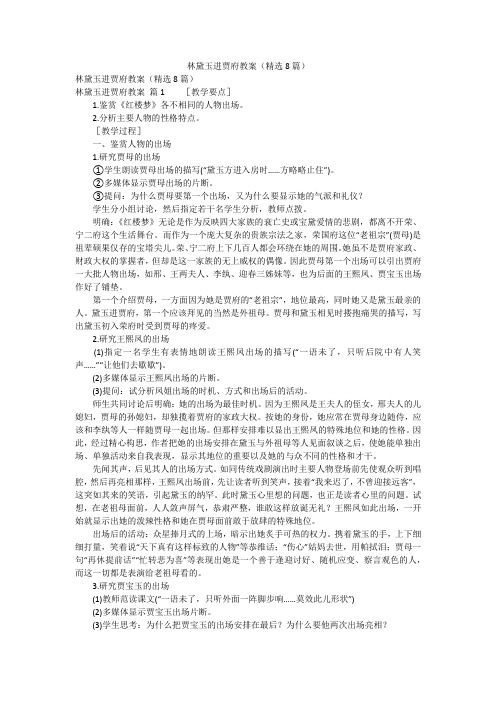
林黛玉进贾府教案(精选8篇)林黛玉进贾府教案(精选8篇)林黛玉进贾府教案篇1[教学要点]1.鉴赏《红楼梦》各不相同的人物出场。
2.分析主要人物的性格特点。
[教学过程]一、鉴赏人物的出场1.研究贾母的出场①学生朗读贾母出场的描写(“黛玉方进入房时……方略略止住”)。
②多媒体显示贾母出场的片断。
③提问:为什么贾母要第一个出场,又为什么要显示她的气派和礼仪?学生分小组讨论,然后指定若干名学生分析,教师点拨。
明确:《红楼梦》无论是作为反映四大家族的衰亡史或宝黛爱情的悲剧,都离不开荣、宁二府这个生活舞台。
而作为一个庞大复杂的贵族宗法之家,荣国府这位“老祖宗”(贾母)是祖辈硕果仅存的宝塔尖儿。
荣、宁二府上下几百人都会环绕在她的周围。
她虽不是贾府家政、财政大权的掌握者,但却是这一家族的无上威权的偶像。
因此贾母第一个出场可以引出贾府一大批人物出场,如邢、王两夫人、李纨、迎春三姊妹等,也为后面的王熙凤、贾宝玉出场作好了铺垫。
第一个介绍贾母,一方面因为她是贾府的“老祖宗”,地位最高,同时她又是黛玉最亲的人。
黛玉进贾府,第一个应该拜见的当然是外祖母。
贾母和黛玉相见时搂抱痛哭的描写,写出黛玉初入荣府时受到贾母的疼爱。
2.研究王熙凤的出场(1)指定一名学生有表情地朗读王熙凤出场的描写(“一语未了,只听后院中有人笑声……”“让他们去歇歇”)。
(2)多媒体显示王熙凤出场的片断。
(3)提问:试分析凤姐出场的时机、方式和出场后的活动。
师生共同讨论后明确:她的出场为最佳时机。
因为王熙凤是王夫人的侄女,邢夫人的儿媳妇,贾母的孙媳妇,却独揽着贾府的家政大权。
按她的身份,她应常在贾母身边随侍,应该和李纨等人一样随贾母一起出场。
但那样安排难以显出王熙凤的特殊地位和她的性格。
因此,经过精心构思,作者把她的出场安排在黛玉与外祖母等人见面叙谈之后,使她能单独出场、单独活动来自我表现,显示其地位的重要以及她的与众不同的性格和才干。
先闻其声,后见其人的出场方式。
- 1、下载文档前请自行甄别文档内容的完整性,平台不提供额外的编辑、内容补充、找答案等附加服务。
- 2、"仅部分预览"的文档,不可在线预览部分如存在完整性等问题,可反馈申请退款(可完整预览的文档不适用该条件!)。
- 3、如文档侵犯您的权益,请联系客服反馈,我们会尽快为您处理(人工客服工作时间:9:00-18:30)。
《林黛玉进贾府》教学设计教案教学设计共3篇《林黛玉进贾府》教学设计教案教学设计1一、教学设计背景《红楼梦》是中国文化的瑰宝,在中国文学史上占据着重要的位置。
在七十年代初,文化大革命期间,教育受到严重限制,许多文艺作品被禁止出版,被称之为“牛鬼蛇神”。
1978年,改革开放政策开启了一扇窗户,文化的大门开始重新向社会开放,这扇窗户为教育提供了更加广阔的东西贡献。
《红楼梦》作为一部经典的文学作品,受到了越来越多人的关注和研究,成为了课堂教学中必不可少的内容。
《林黛玉进贾府》是《红楼梦》的开篇之作,也是整个小说情节的关键所在。
如何在普及《红楼梦》的同时,激发学生对于文学的浓厚兴趣,让学生体会到文学的魅力,是每一位语文老师思考的命题。
二、教学目标1. 了解《林黛玉进贾府》的背景知识与基本情节。
2. 能够分析《林黛玉进贾府》中人物性格、形象等方面的特点。
3. 能够体会《林黛玉进贾府》中反映社会现象的细节、见解和思想。
4. 学会运用所学的语文知识,深入自己的思想和情感,并能通过文字表达出来。
三、教学过程1. Warm up (10 minutes)a. Review the characters and main events from previous lessons: Make sure students have already read the text and can understand the simple outline of the story.b. Provide additional background information about the Qing Dynasty, which is when this story was written.2. Pre-reading Activities (10 minutes)a. Introduce the title of the story and discuss with students what their expectations are for the story.b. Ask students to work together in pairs or small groups to brainstorm what they think might happen (predictions). The teacher should also give students a chance to share their guesses.3. Reading activity (20 minutes)a. Read the opening chapter of《林黛玉进贾府》to the class. Prior to the reading, explain to students that they should think of questions during the reading andthat you will pause at certain points to check their understanding.b. Introduce some new vocabulary in the text and make sure that students understand these new words.4. Post-reading Activity (20 minutes)a. Ask students to work in pairs or small groups to discuss the chapter they just read. Ask for each group to provide a summary of their discussion to share with the class. This will help give all students different perspectives on the text.b. Using document cameras and overhead projectors, model sentence writing and demonstrate how to use keywords/strategies about relevant sections from the chapter.5. Collaborative Project (25 minutes)The teacher will assign small groups or pairs the task of creating a visual representation, such as a poster, that provides an overview of the chapter. They can be creative and use multiple formats. The teacher can also include writing pr ompts to guide the students’ thinking as they reflect on the text. All groups willpresent their visual representation to the class, explaining what they have learned from the text and their team’s thinking strategies.6. Culminating Activity (10 minutes)The teacher will lead a class discussion asking students to share their opinions about the novel's protagonist (Lin Daiyu) and other characters, and also share their emotions about the story.四、评价和检查The teacher will use formative and summative assessments throughout the process of teaching the text. Formative assessments will include regular checks for understanding during class discussions, visual representations, and reflection writing. Additionally, summative assessments will also include a written assessment where students will be given 1 hour to write an essay about the character, Lin Daiyu. They will be questioned on her character traits, her role in the story, the impact of the story on the Qing Dynasty society, and the literary significance of her role as a storytellerIn conclusion, the study of Dream of the Red Chamber and the character Lin Daiyu offers a valuable opportunity for students to engage with Chinese literature and culture. By exploring the complex themes of love, family, and social status, studentswill gain a deeper understanding of the historical context of the Qing Dynasty and the enduring impact of this classic novel. Through a variety of formative and summative assessments, students will develop their critical thinking and analytical skills, as well as their ability to communicate their ideas effectively through writing. Overall, this unit has the potential to inspire a lifelong appreciation for Chineseliterature and culture, while providing students with important skills and knowledge that will benefit themin all areas of their academic and personal lives《林黛玉进贾府》教学设计教案教学设计2《林黛玉进贾府》教学设计教案教学设计一、教学目标1. 了解小说《红楼梦》中以林黛玉为主角的情节及人物形象。
2.了解清代女性的地位和生活状况,懂得珍惜现在的幸福生活,尊重女性。
3.培养学生的阅读能力,提高学生的语言表达能力和写作能力。
4.使学生能够用丰富的语言表达自己的看法和情感,提高学生的感性认识和审美能力。
5. 培养学生的对文本的分析和理解能力,以及对小说情节的思考和评论能力。
二、教学内容1.小说《红楼梦》的背景和作者介绍;2.小说《红楼梦》中林黛玉的形象和性格特点;3.小说《红楼梦》中林黛玉与其他人物的关系;4.小说《红楼梦》中林黛玉的悲剧命运分析;5.小说《红楼梦》中女性的地位和生活状况。
三、教学重点1. 了解小说《红楼梦》中以林黛玉为主角的情节及人物形象。
2. 了解清代女性的地位和生活状况。
四、教学方法1.讲授法:通过讲解和讲述故事,帮助学生理解故事情节。
